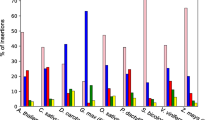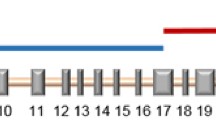Abstract
A degenerative syndrome associated with the accumulation of site-specific deletions within mitochondrial chromosomes occurs in strains of Podospora anserina carrying the AS1-4 nuclear mutation. The site-specific deletion event has been assumed to result from the transposition of a group-II intron (intron α) behind an IBS motif, followed by recombination between the two intron repeats. We show here that a number of distinct deletions can accumulate in AS1-4 strains. Most of them are present in low amounts in wild-type cells where they are only detectable in PCR experiments. The deletions can be divided into two classes. In class I, intron α is joined to an IBS motif. In class II, the intron is not joined to an IBS site, it can be truncated or contain a few upstream exonic nucleotides; some junctions carry non-templated nucleotides. These results indicate that at least two mechanisms are involved in the generation of large-scale mitochondrial deletions in Podospora. One of them seems to be based on the transposition properties of the group-II α intron, the other one on illegitimate recombination. We propose that these two mechanisms use DNA double-strand breaks occurring within the 5′ region of intron α.
Similar content being viewed by others
Author information
Authors and Affiliations
Additional information
Received: 15 May / 18 August 1998
Rights and permissions
About this article
Cite this article
Sainsard-Chanet, A., Begel, O. & d'Aubenton-Carafa, Y. Two co-existing mechanisms account for the large-scale deletions of mitochondrial DNA in Podospora anserina that involve the 5′ border of a group-II intron. Curr Genet 34, 326–335 (1998). https://doi.org/10.1007/s002940050403
Issue Date:
DOI: https://doi.org/10.1007/s002940050403




